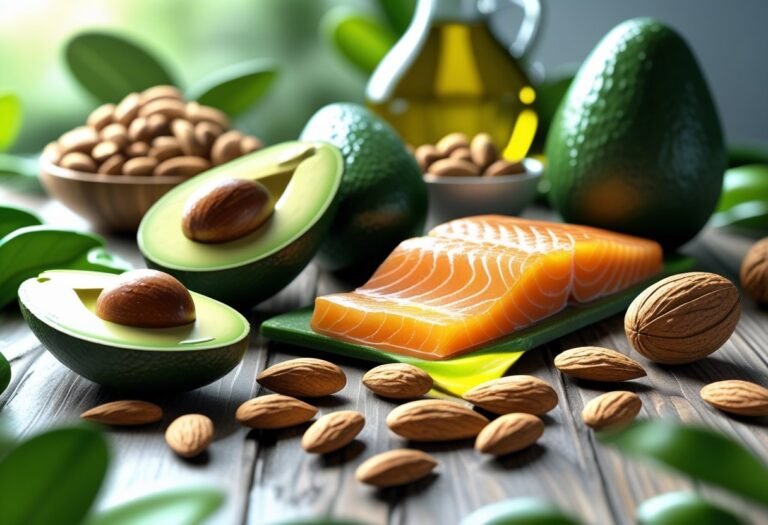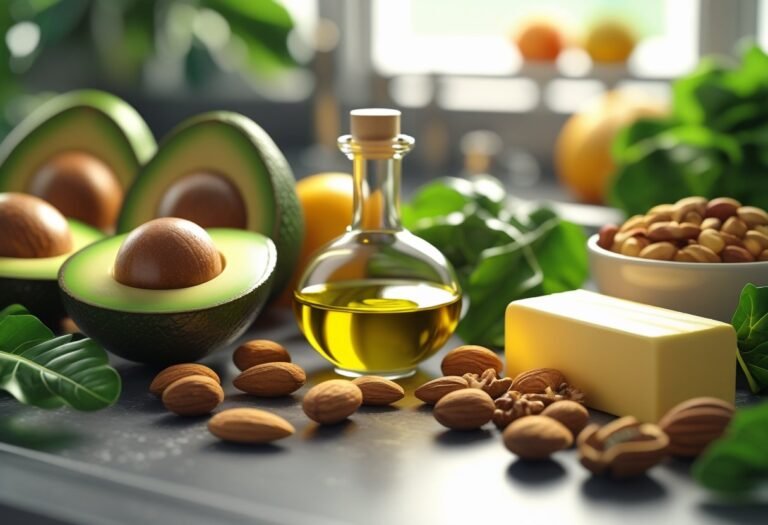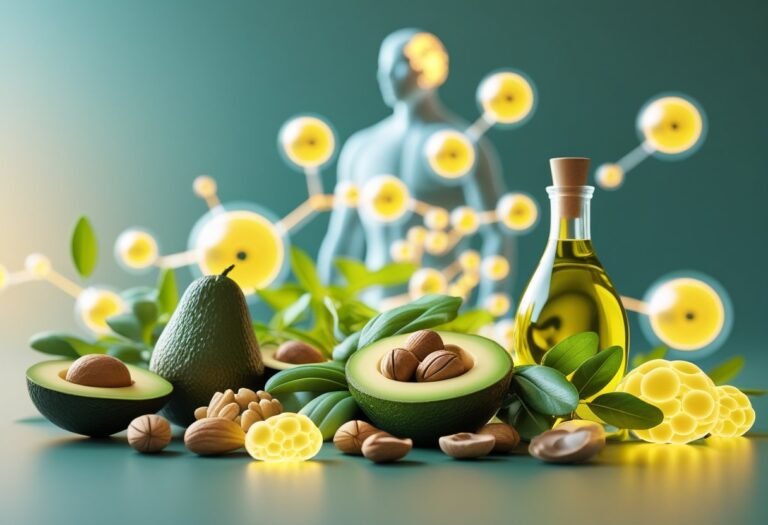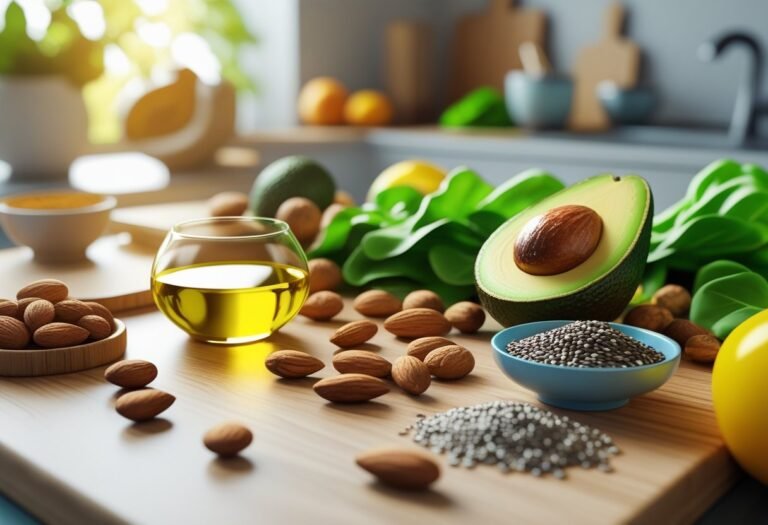The Truth About Optavia Healthy Fats: What Everyone Gets Wrong
When you start the Optavia program, you’ll quickly discover that healthy fats are one of the most misunderstood parts of this weight loss solution. Many people think they need to avoid fats completely or assume all fats are created equal on this plan.

The Optavia program actually allows up to 2 servings of healthy fats per day in your lean and green meals, but most dieters either skip them entirely or choose the wrong types. This mistake can slow your weight loss and leave you feeling hungry between meals. The Optavia diet prescribes specific portions that include healthy fats like olive oil, olives, and avocado as part of your daily intake.
Understanding which fats to include and how much to eat can make the difference between struggling on the plan and seeing real results. Your success depends on getting these details right from the start.
What You’ll Learn?
- Optavia allows up to 2 servings of approved healthy fats daily but most people use them incorrectly
- Common fat mistakes include avoiding them completely or choosing processed options instead of whole food sources
- Proper fat intake supports weight loss by improving satiety and nutrient absorption on the program
Unpacking Optavia Healthy Fats: What the Diet Really Recommends
The Optavia diet includes specific guidelines for healthy fats that require 5 grams of fat and less than 5 grams of carbs per serving. Your lean and green meals can include 0-2 servings depending on your protein choices.
Definition and Role of Healthy Fats in the Optavia Diet
Healthy fats are an essential component of your Optavia meal plan and provide important nutritional benefits. The diet focuses on monounsaturated and polyunsaturated fats rather than saturated fats.
A healthy fat serving should contain about 5 grams of fat and less than 5 grams of carbohydrate. This specific ratio helps maintain the low-carb structure of your lean and green meals.
The fats serve multiple purposes in your nutrition plan. They help your body absorb vitamins and provide energy between your Optavia fuelings.
Your healthy fat intake varies based on your protein selection. Leaner proteins allow for more fat servings in each meal.
Approved Healthy Fat Sources for Lean and Green Meals
Optavia recommends specific healthy fat options including avocados, olive oil, almonds, peanuts, sesame seeds, chia seeds, flax seeds, and pumpkin seeds. Butter, margarine, and mayonnaise are also approved choices.
Plant-based options:
- Avocados
- Olive oil
- Nuts (almonds, peanuts)
- Seeds (chia, flax, pumpkin, sesame)
Other approved fats:
- Butter
- Margarine
- Mayonnaise
The majority of your healthy fat servings should come from monounsaturated and polyunsaturated sources. These provide better health benefits than saturated fat options.
Each approved fat must meet the 5-gram fat, under 5-gram carb requirement. This keeps your lean and green meals within the proper macronutrient ranges.
Typical Serving Sizes and Meal Planning Guidelines
Your serving amounts depend on your protein choice for each lean and green meal. You’ll have 0-2 servings of healthy fats per lean and green meal.
Optavia recommends one serving for leaner protein options and two servings for the leanest protein options. This balances your total calorie and fat intake across the meal.
Typical serving examples:
- 1/3 medium avocado
- 1 teaspoon olive oil
- 10-12 almonds
- 1 tablespoon seeds
Your meal planning should include these fats to meet nutritional needs. They work alongside your vegetables and protein to create balanced lean and green meals that complement your daily Optavia fuelings.
Common Misconceptions About Healthy Fats on Optavia

Many people starting the Optavia program wrongly believe all fats will slow their weight loss or that eliminating fats completely leads to better results. These outdated ideas about fat intake can actually hurt your progress and health on this low calorie diet.
Why People Fear or Avoid Fats on the Optavia Program
You might worry that eating any fat will stop your weight loss on Optavia. This fear comes from decades of low-fat diet messages that painted all fats as bad.
The truth is different. Fat myths have been around for years because health guidelines once pushed very low-fat eating. Many people still think fat isn’t needed in our diet at all.
On the Optavia program, you’re already eating fewer calories to create a calorie deficit. Adding the right fats won’t stop this process. Your body needs fat to work properly.
Key reasons people avoid fats on Optavia:
- Old beliefs that fat makes you gain weight instantly
- Fear of going over their daily calorie intake
- Confusion about which fats are actually healthy
- Thinking the calorie deficit won’t work with any fat
The Optavia program actually includes specific healthy fat guidelines for good reasons. These fats support your healthy eating goals rather than hurt them.
The Myth of Low-Fat Always Being Better for Weight Loss
You might think cutting out all fats will speed up your weight loss on this low calorie diet. This isn’t true and can actually make your results worse.
Fat helps you feel full longer after meals. Without enough fat, you may feel hungry sooner and want to eat more. This makes it harder to stick to your calorie deficit.
What happens when you avoid all fats:
- You feel less satisfied after eating
- Your energy levels may drop
- Your body can’t absorb certain vitamins properly
- You might have trouble maintaining this healthy habit long-term
Research shows that including healthy fats can provide important health benefits for your body. These fats are an essential part of balanced healthy eating.
The Optavia program allows 0-2 servings of healthy fats per lean and green meal based on your protein choices. This isn’t by accident – it’s designed to support your success.
Importance of Not Eliminating All Fats
Your body needs fat to function properly, even on a low calorie diet like Optavia. Cutting out all fats can hurt your health and make the program harder to follow.
Fat helps your body absorb vitamins A, D, E, and K. Without enough fat, you can’t use these vitamins properly. This can affect your energy and overall health while you’re losing weight.
Essential functions of dietary fat:
- Helps absorb fat-soluble vitamins
- Supports hormone production
- Keeps your skin and hair healthy
- Provides steady energy between meals
The Optavia program includes healthy fats because they support your weight loss goals. Each healthy fat serving should contain about 5 grams of fat and less than 5 grams of carbs.
Smart fat choices help you build sustainable healthy eating patterns. When you include the right amounts of healthy fats, you’re more likely to stick with the program long-term and maintain your results.
The Critical Link Between Healthy Fats, Nutrition, and Weight Loss Outcomes

Healthy fats play a crucial role in maintaining your metabolism, preserving muscle tissue, and preventing the negative side effects that often accompany extreme calorie restriction. Without adequate fat intake, your body struggles to burn stored fat efficiently and may begin breaking down lean muscle mass instead.
How Healthy Fats Support Fat Burning and Lean Muscle Mass
Your body needs dietary fats to produce hormones that regulate metabolism and fat burning. When you drastically cut fats, your testosterone and growth hormone levels drop significantly.
This hormonal disruption makes it harder for your body to maintain lean muscle mass during weight loss. Research shows that 20-30% of daily calories should come from healthy fats when pursuing weight loss.
Key fat-burning benefits include:
- Enhanced hormone production for metabolism
- Better absorption of fat-soluble vitamins A, D, E, and K
- Improved satiety that prevents overeating
- Stable blood sugar levels throughout the day
Monounsaturated and polyunsaturated fats from sources like olive oil, nuts, and fish actively support your body’s ability to access stored fat for energy. These fats help maintain the cellular processes that keep your metabolic rate elevated.
Without enough dietary fat, your metabolism slows down as a protective mechanism. This makes long-term weight loss much more difficult to achieve and maintain.
Consequences of Inadequate Fat Intake: Hair Loss, Fatigue, and More
Severe fat restriction triggers multiple deficiency symptoms that signal your body is under nutritional stress. Hair loss becomes noticeable within 2-3 months of inadequate fat intake.
Your hair follicles need essential fatty acids to maintain their growth cycle. Without these fats, hair becomes thin, brittle, and may fall out in larger amounts than normal.
Common symptoms of fat deficiency:
- Chronic fatigue and low energy levels
- Dry, flaky skin and brittle nails
- Difficulty concentrating or brain fog
- Increased hunger and food cravings
- Poor wound healing
Fatigue occurs because your brain relies on fats for proper neurotransmitter function. Essential fatty acids help produce serotonin and dopamine, which regulate mood and energy.
Your cell membranes also depend on adequate fat intake to function properly. When these membranes become rigid from fat deficiency, nutrient transport becomes less efficient throughout your body.
Sustainable Weight Loss vs. Rapid Short-Term Results
Rapid weight loss through extreme calorie restriction and fat elimination creates metabolic damage that makes regaining weight almost inevitable. Your body interprets severe restrictions as starvation.
Sustainable weight management requires a comprehensive approach that includes adequate healthy fats rather than focusing solely on short-term results.
Sustainable approach characteristics:
- Moderate calorie deficit with adequate fats
- Preservation of lean muscle mass
- Stable energy levels throughout the process
- Reduced risk of nutritional deficiencies
When you include healthy fats in your weight loss plan, you lose weight more slowly but maintain it more effectively. Your metabolism stays higher, and you avoid the rebound weight gain common with rapid approaches.
Evidence suggests focusing on dietary patterns with healthy fats rather than eliminating entire macronutrient groups. This approach supports both immediate results and long-term success.
Your body needs time to adapt to new eating patterns. Gradual changes that include appropriate fat intake create lasting habits rather than temporary restrictions.
Expert Guidance and Practical Tips for Integrating Healthy Fats on Optavia

Professional guidance helps you make smart choices about healthy fats while following Optavia’s structured approach. The key is finding the right balance between program requirements and long-term eating habits that support your health goals.
What Registered Dietitians and Personal Trainers Advise
A registered dietitian will tell you that healthy fats are essential for your body even on a meal replacement plan. They stress that you should not skip these important nutrients.
Most dietitians recommend focusing on monounsaturated and polyunsaturated fats over saturated fats. These include olive oil, avocado, and nuts within your allowed portions.
Personal trainers often see clients who avoid all fats when trying to lose weight. This is a mistake that can hurt your energy levels and workout performance.
Key professional recommendations:
- Stick to the 5-gram serving size guideline
- Choose quality sources like olive oil and nuts
- Don’t eliminate fats completely from your diet
Registered dietitians warn against developing disordered eating patterns. They want you to see fats as helpful, not harmful to your goals.
How to Balance Healthy Fats with Vegetables and Protein
Your Lean & Green meals need the right mix of all three components. You can have 0-2 servings of healthy fats depending on your protein choice.
Simple balancing formula:
- Protein: 5-7 ounces of lean meat, fish, or eggs
- Vegetables: 3 servings of low-carb options
- Healthy fats: 0-2 servings based on your protein
When you cook vegetables, a small amount of olive oil helps your body absorb fat-soluble vitamins. This makes your meal more nutritious overall.
Avoid adding fats to already fatty proteins like salmon. Instead, save your fat servings for cooking vegetables or as a salad dressing.
Practical meal examples:
- Grilled chicken with roasted vegetables cooked in 1 tsp olive oil
- Lean fish with steamed broccoli and a small handful of almonds
- Egg white omelet with vegetables cooked in cooking spray
Transitioning from Optavia to Long-Term Healthy Eating
Moving beyond the structured meal plans requires you to understand portion control for life. The habits you learn on Optavia should carry forward into regular eating.
Start adding back whole grains and low-fat dairy slowly. These foods were limited during your weight loss phase but become important for long-term health.
Transition strategy:
- Keep using the plate method – half vegetables, quarter protein, quarter whole grains
- Continue measuring fat portions until portion awareness becomes natural
- Add variety while maintaining the balance you learned
Many people struggle with this phase because they lose the structure of meal replacement plans. Having a plan prevents you from falling back into old eating patterns.
Work with a registered dietitian during this transition if you have concerns about developing an eating disorder. They can help you create sustainable meal plans that include all food groups in appropriate amounts.
Remember that healthy eating is about balance, not restriction. The skills you developed on Optavia should support a lifetime of good nutrition choices.
Frequently Asked Questions
1. What happens if I skip healthy fats completely?
2. What are some approved Optavia healthy fat sources?
3. Why do some people fear eating fat on Optavia?
4. What are the risks of too little fat on a low-calorie diet like Optavia? Too little fat can cause:
5. Can I continue healthy fats after finishing Optavia?
Lose Up to 5kg in 7 Days? This Weight Loss Plan Explained
This weight loss plan is all about creating a calorie deficit and building habits that help you lose weight quickly, but without going overboard.
Read more